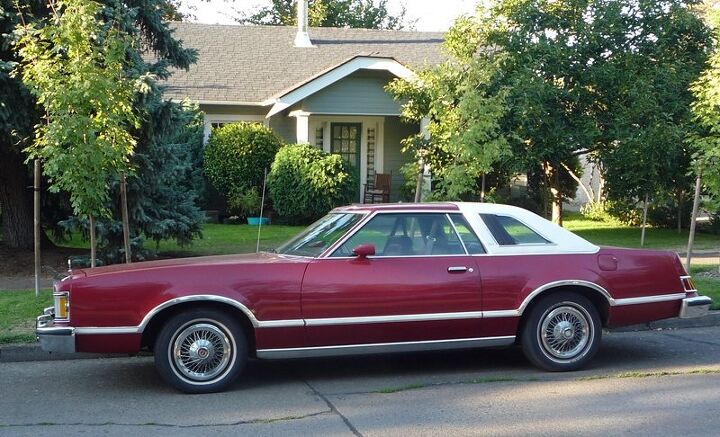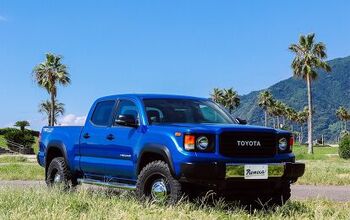Curbside Classic Mercury Memorial Week Finale: The Fat Cats – 1971, 1974 And 1977 Cougar

The Cougar first arrived in 1967 as something unique and distinct: a handsome, lithe sporty coupe with a distinct hint of luxury and a dash of continental flavor. Although the 1969 Pontiac Grand Prix is often credited with creating the mid-size/mid-price personal-luxury coupe coup, the first Cougar certainly predicted the trend.
What wasn’t so predictable is how quickly the Cougar would slather on the pounds (tons?), and morph into just another bland also-ran competitor in that rapidly crowding field. And if that weren’t bad enough, the once exclusive Cougar name was sullied by four door sedans and even a station wagon. The seventies were not kind to the Cougar, and (surprise) we’re not going to be very kind to it.
The Cougar (de)evolved rapidly in the decade after its arrival, with a total of five distinct generations in that time period. We covered the ’67-’68 and had a brief look at the already plumper ’69-’70 in our recent CC. They both followed the Mustang’s trajectory, largely sharing its platform and body shell, with a couple of extra inches of wheelbase, but with highly differentiated styling. And just like the 1971 Mustang went overboard in size and girth for a so-called pony car, so did the Cougar.
This was during Semon E. “Bunkie” Knudsen’s brief tour of duty at the helm of Ford, and his efforts to bring Pontiac noses and other GM-esque design elements are all-too obvious. Four years after the ’67’s distinctive styling and very successful start, the 1971 Cougar was totally unrecognizable as its successor. What a way to destroy equity in a successful and unique identity.
It wasn’t just that it looked nothing like its memorable predecessors; it now also shared way too much family-arity with the Mustang. Mercury was reverting back to Ford form.
Admittedly, this car’s interior has seen better days, but even in its prime, there wasn’t a whiff of Jaguar here. Go back and compare it to the ’67-’68 interior. What a come-down; this might as well be a Pinto Bobcat. Not surprisingly, sales were also a huge come-down; for these ’71-’73 Cougars they were off a whopping 66% from the original. As was performance, fuel efficiency, handling, taste, and all-round desirability. The only thing that was up was weight (500+ lbs), but that was just an appetizer of things to come.
For 1974, the Cougar stopped pretending to be a more exclusive variant of a pony car, and joined the burgeoning mega-mid-sized personal luxury coupe market. This was the hot category in the seventies, led by the Grand Prix, Monte Carlo, Cutlass Supreme and a host of hangers-on. Ford, which had been so successful in creating niche vehicles in the late fifties (T-Bird) and the sixties (Mustang), was caught flat-footed with this monster trend, but jumped in late in 1974 with their delightfully refreshing and highly original Gran Torino Elite. Its great innovation and claim to fame was two “opera windows” per side. It must have been fun to be an automotive designer in Detroit during the seventies.
The Cougar was invited to slip into an Elite suit in 1974 too, but it was a mighty heavy one. Now the Cougar weighed some 50% more than it did in 1967, well over two tons. And don’t even ask about performance. Somehow, Ford managed to eke less power out of its engines during the seventies than anyone else: the 400 CID (6.6 L) V8 managed 158 hp; the big block 460 (7.5 L) squeezed out all of 216 hp. The bad old days. And no; torque isn’t a direct substitute for horsepower.
But Lo! Sales began to recover after the low point of ’71 – ’73. Folks took a shine to cars like this fine 1974 XcRement 7, which this owner can’t bear to have the garbage men haul off with the cans, despite how happy it would make the neighbors (he used to have a minor junk yard of vintage Ford iron, but this one survived the cull).
Now we reach 1977-1979, the pinnacle of Cougar size and taste. OK, I know some of you have a soft spot for these lovely cars, and what can I say, other than you’re obviously delusional devoted. Just kidding; aren’t these just ah…ah…wonderful. I just don’t feel like hurting anybody’s feelings today; I do that way too often. Well, it’s good to know someone loves these, because otherwise I wouldn’t have run into this remarkably well kept example. Curiously enough, I found it the same beautiful summer day as I found its very similar red stablemate, the Thunderbird (lower picture).
The family genes are in full display here, eh? The T-Bird was given that precious little slanted opera window, but other than that, I bet it would be mighty easy to swap fenders, doors, bumpers and almost everything else except that opera window on these kissing cousins.
From the very distinctive ’67 Cougar’s electric-razor face, we now gaze on the universal seventies’ Ford face, practically interchangeable with everything from the compact Granada to the mighty Continental. It might have been hard to tell what model was coming down the road, but you just knew it was a Ford. Brilliant!
Now the Cougar suffered much further indignities than just being a badge-engineered clone of a badge-engineered clone of a copy of a GM coupe. Now, the once proud and exclusive Cougar name now could also be had on a four door sedan, and…
Yes! A Cougar station wagon! It’s exactly what the world was holding its breath for. Or was it after they saw it? More likely, since the wagon went over like a hearse; only 4,951 buyers still had enough breath left to actually buy one. It was a one-year wonder, and probably highly collectible by now. I don’t expect to find one.
Mercury’s big marketing theme in the seventies was to more closely ally itself with the Lincoln and Continental. As a result, the Cougar now even sprouted a Conti-inspired butt bulge. Yes, the Cougar was all-too obviously now trying to be a budget-priced Mark IV than an original American take on a Jag. Why try harder?
Ok, even if the exterior styling is very much a question of (questionable) taste, at least the dash and interior were getting relatively better. Compare it to the ’71 above and we have genuine progress! And some commentators thought I was being too harsh on the dreadful Marauder X-100 dash, but look at how much better this is than that too! I didn’t say inspired, just not as bad. The mystery here is why one seat is cloth and the other leather or vinyl. A Monday car, or?
All right, we’ve been harsh enough on this poor big fat dull dumb Cougar. It looks so lovely sitting here on a summer’s evening. What a period piece. But then I just noticed that the very next car I shot on this glowing sunset was our CC logomobile. Compared to the true classic American coupes, this Cougar will always be relegated to a warm-up act, no matter how golden the sunshine. Adios, Mercury! We miss you already.

More by Paul Niedermeyer
Latest Car Reviews
Read moreLatest Product Reviews
Read moreRecent Comments
- MaintenanceCosts Nobody here seems to acknowledge that there are multiple use cases for cars.Some people spend all their time driving all over the country and need every mile and minute of time savings. ICE cars are better for them right now.Some people only drive locally and fly when they travel. For them, there's probably a range number that works, and they don't really need more. For the uses for which we use our EV, that would be around 150 miles. The other thing about a low range requirement is it can make 120V charging viable. If you don't drive more than an average of about 40 miles/day, you can probably get enough electrons through a wall outlet. We spent over two years charging our Bolt only through 120V, while our house was getting rebuilt, and never had an issue.Those are extremes. There are all sorts of use cases in between, which probably represent the majority of drivers. For some users, what's needed is more range. But I think for most users, what's needed is better charging. Retrofit apartment garages like Tim's with 240V outlets at every spot. Install more L3 chargers in supermarket parking lots and alongside gas stations. Make chargers that work like Tesla Superchargers as ubiquitous as gas stations, and EV charging will not be an issue for most users.
- MaintenanceCosts I don't have an opinion on whether any one plant unionizing is the right answer, but the employees sure need to have the right to organize. Unions or the credible threat of unionization are the only thing, history has proven, that can keep employers honest. Without it, we've seen over and over, the employers have complete power over the workers and feel free to exploit the workers however they see fit. (And don't tell me "oh, the workers can just leave" - in an oligopolistic industry, working conditions quickly converge, and there's not another employer right around the corner.)
- Kjhkjlhkjhkljh kljhjkhjklhkjh [h3]Wake me up when it is a 1989 635Csi with a M88/3[/h3]
- BrandX "I can charge using the 240V outlets, sure, but it’s slow."No it's not. That's what all home chargers use - 240V.
- Jalop1991 does the odometer represent itself in an analog fashion? Will the numbers roll slowly and stop wherever, or do they just blink to the next number like any old boring modern car?














































Comments
Join the conversation
I love these cars. I thought they were beautiful when they were new and I still do.
refreshing ford elite !!! you've got to be kidding ,obviously the clowns that write this stuff haven;t a clue !!!! 71-73 cougar is awesome , much better then a 67 model cougar .... owner of 69 xr7 and 72 xr7 !!